Virtual teams in the digital age
The world, nowadays, is closer and closer thanks to information communication technology
(ICT). Actually, virtual teams are considered as a great way to connect people and bring advantages to
organizations. From the existing literature, it is expected to extend knowledge about two big issues: the
global virtual teams and ICT, as well as their benefits and drawbacks. For doing so, many academic and
scientific journals are used for the purposes of summarizing and synthesizing. This study is secondary
research combining some practices to explore the issue. On the one hand, virtual teams enable to cooperate
with members from different geography and time zones. On the other hand, organizations have to deal
with many challenges when applying them. Two typical examples of a reputable global brand and the
success of a national company are presented to explain this issue, including IBM Company in the USA and
FPT Group in Vietnam. By identifying the pros and cons, organizations can suggest suitable solutions to
manage and establish their teams in a better way.
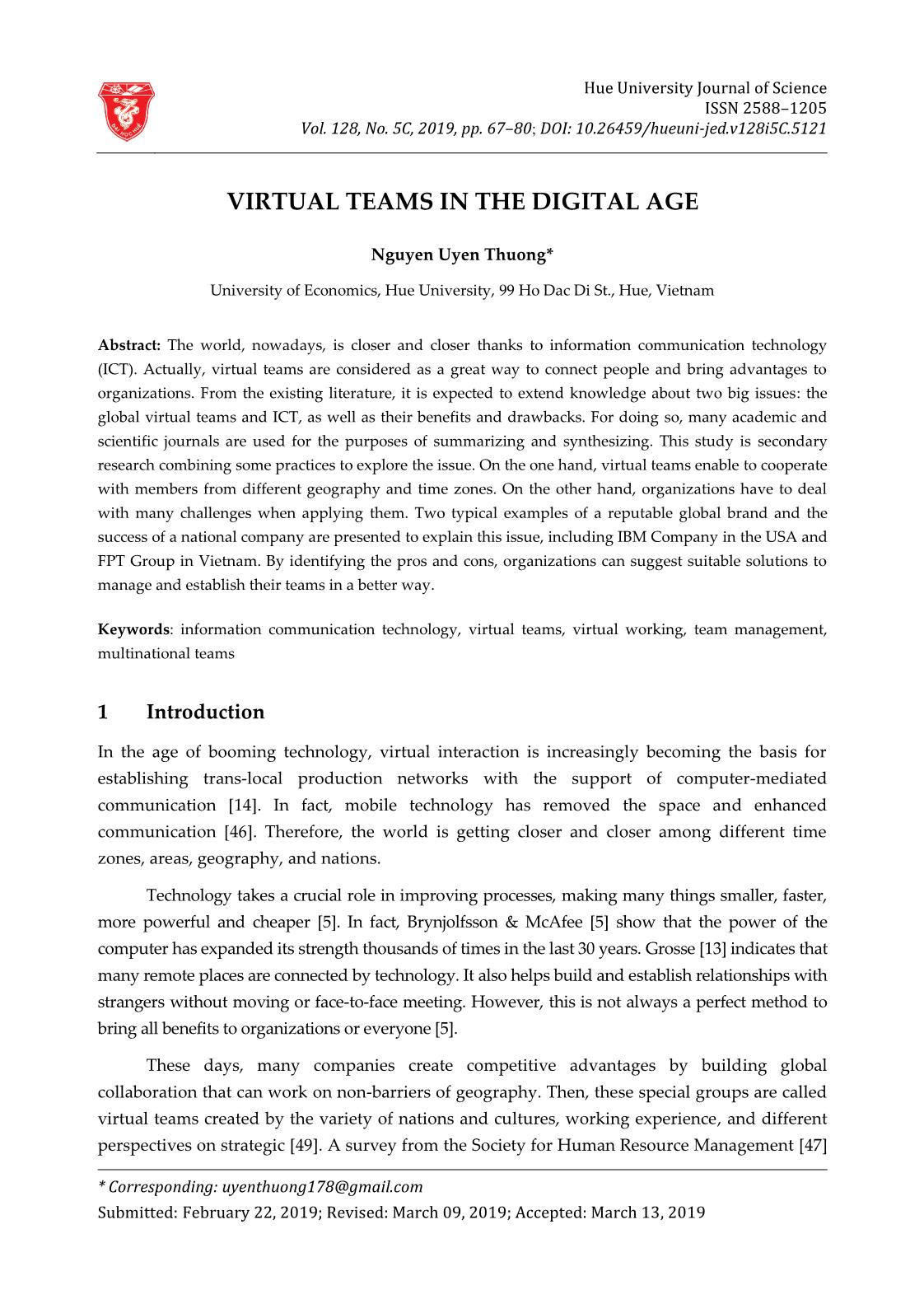
Trang 1
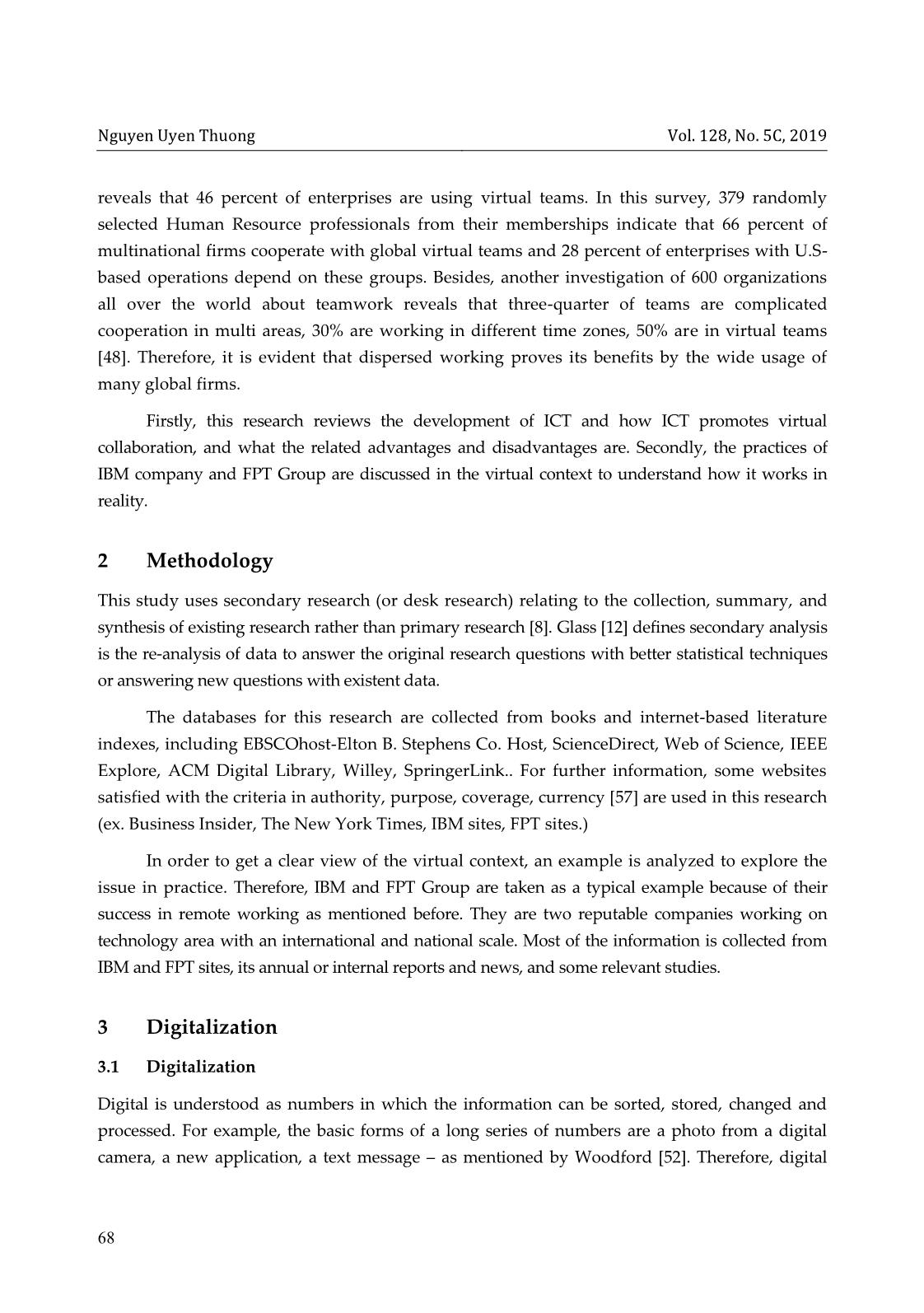
Trang 2
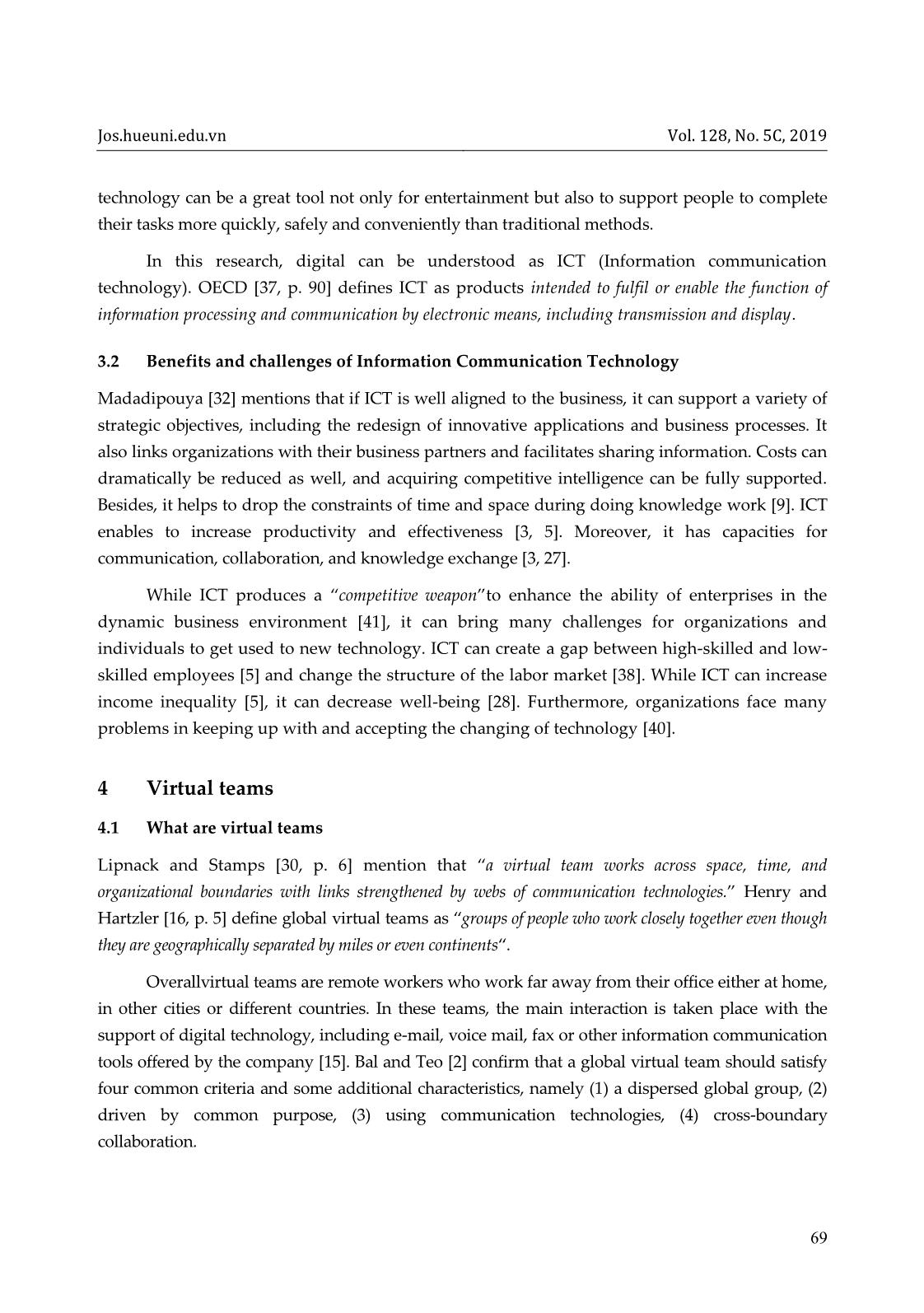
Trang 3
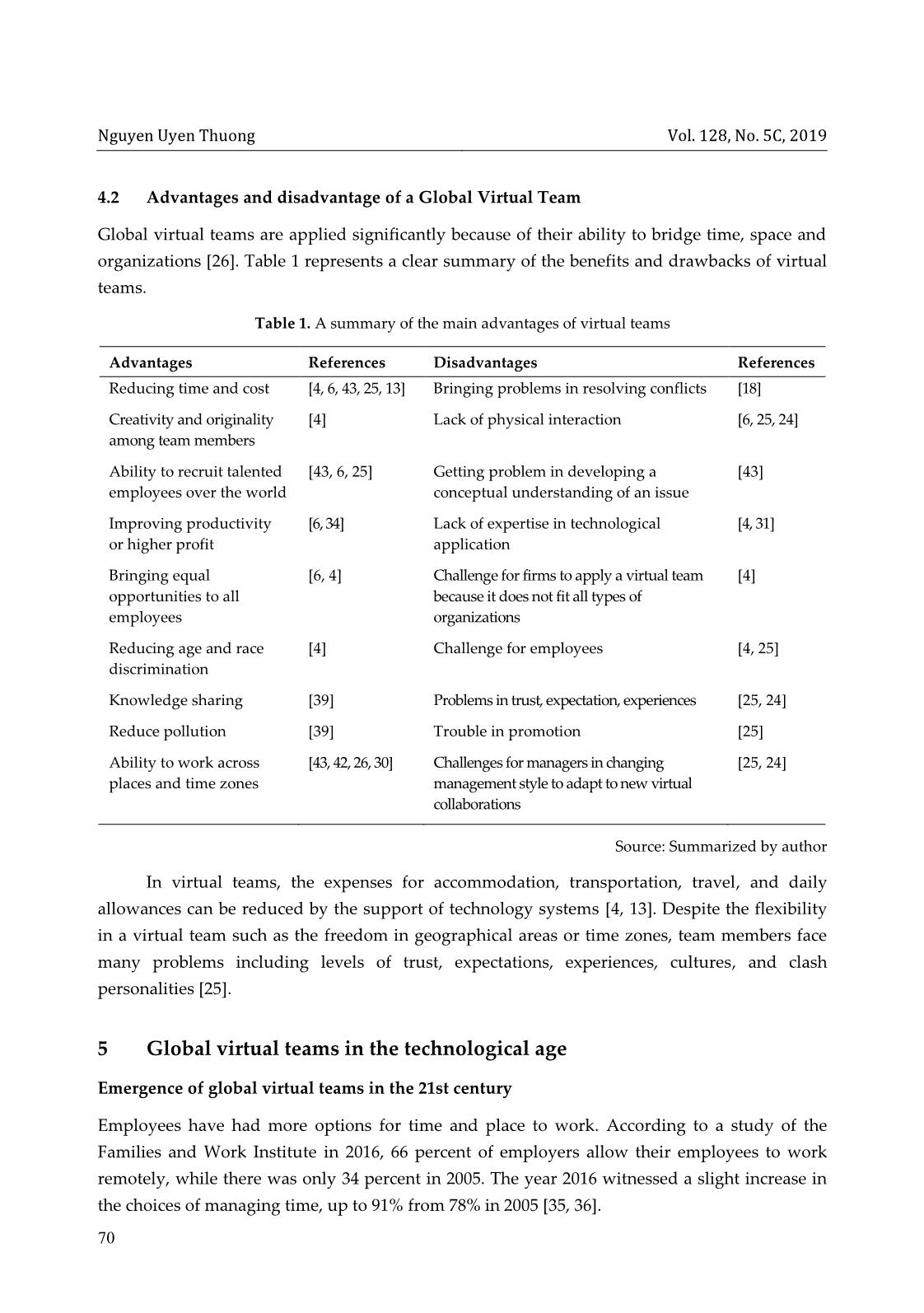
Trang 4
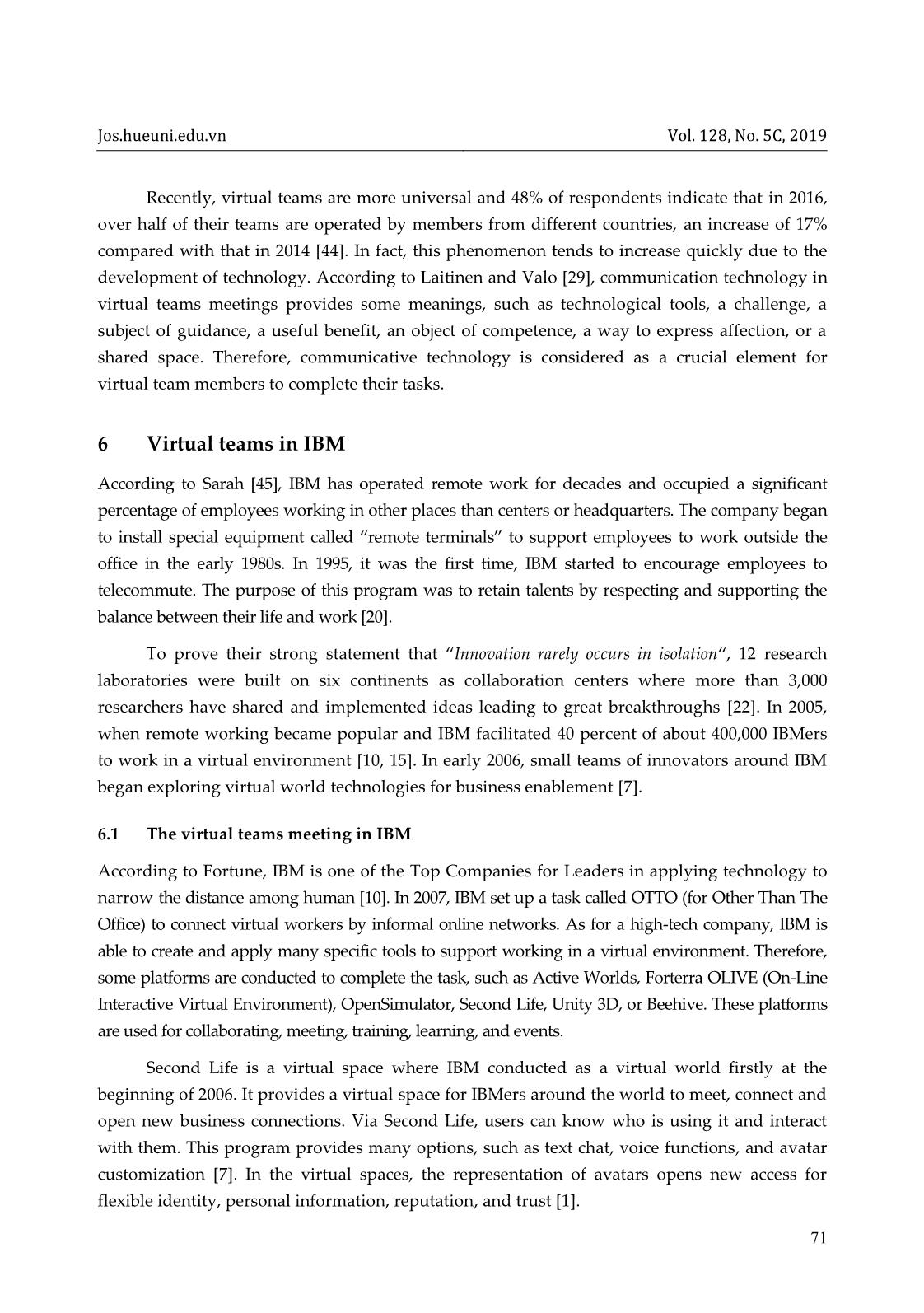
Trang 5
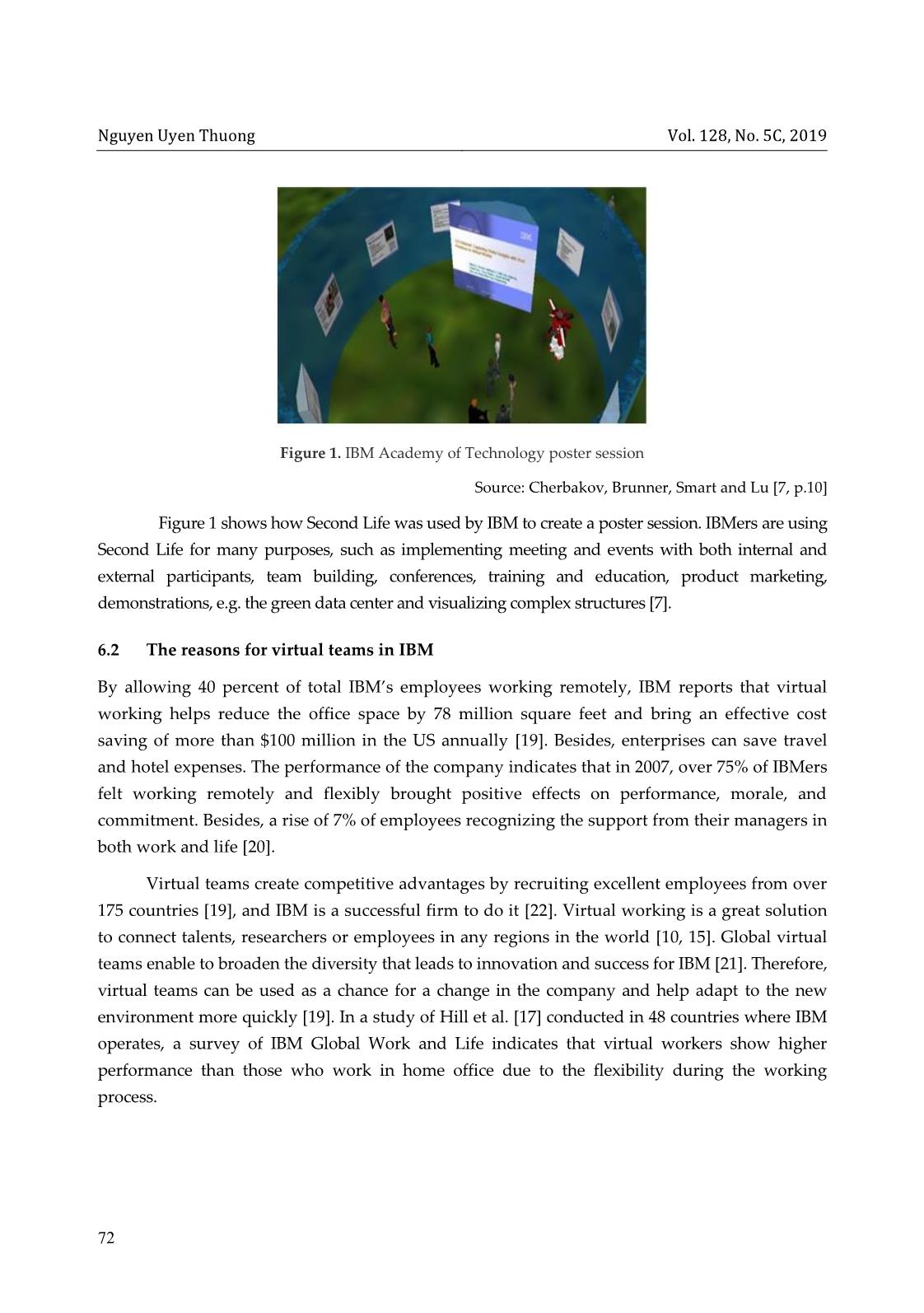
Trang 6
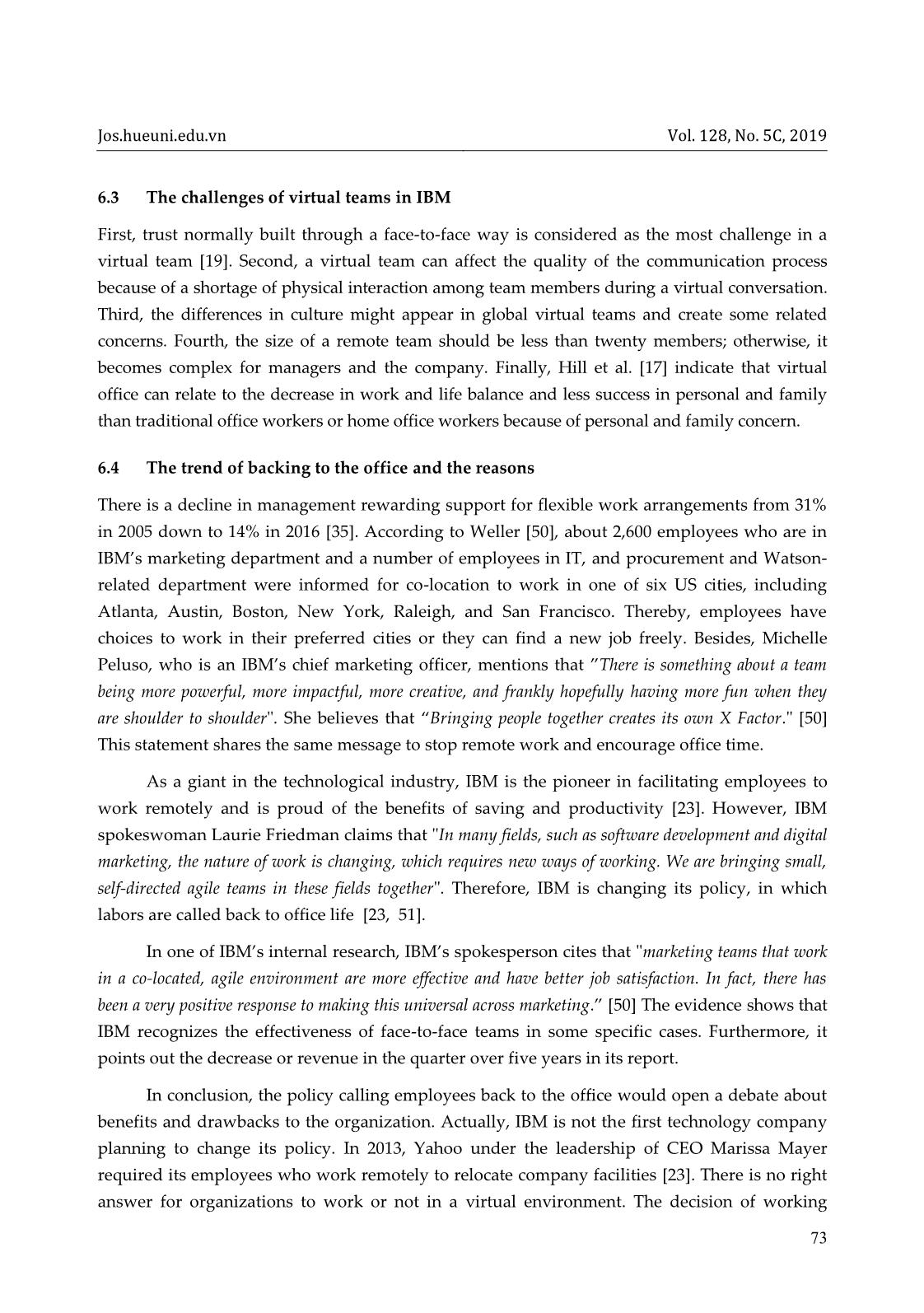
Trang 7
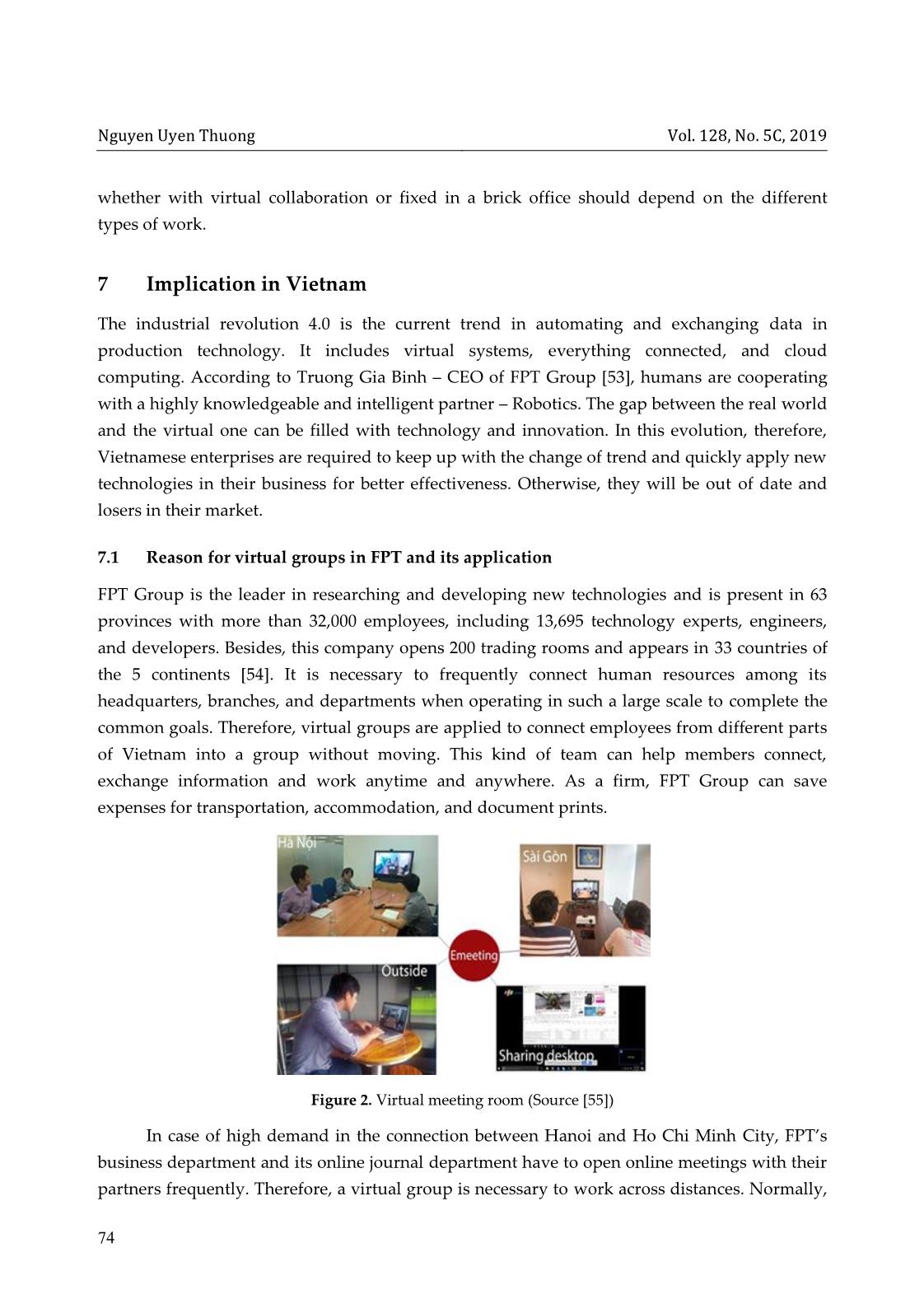
Trang 8
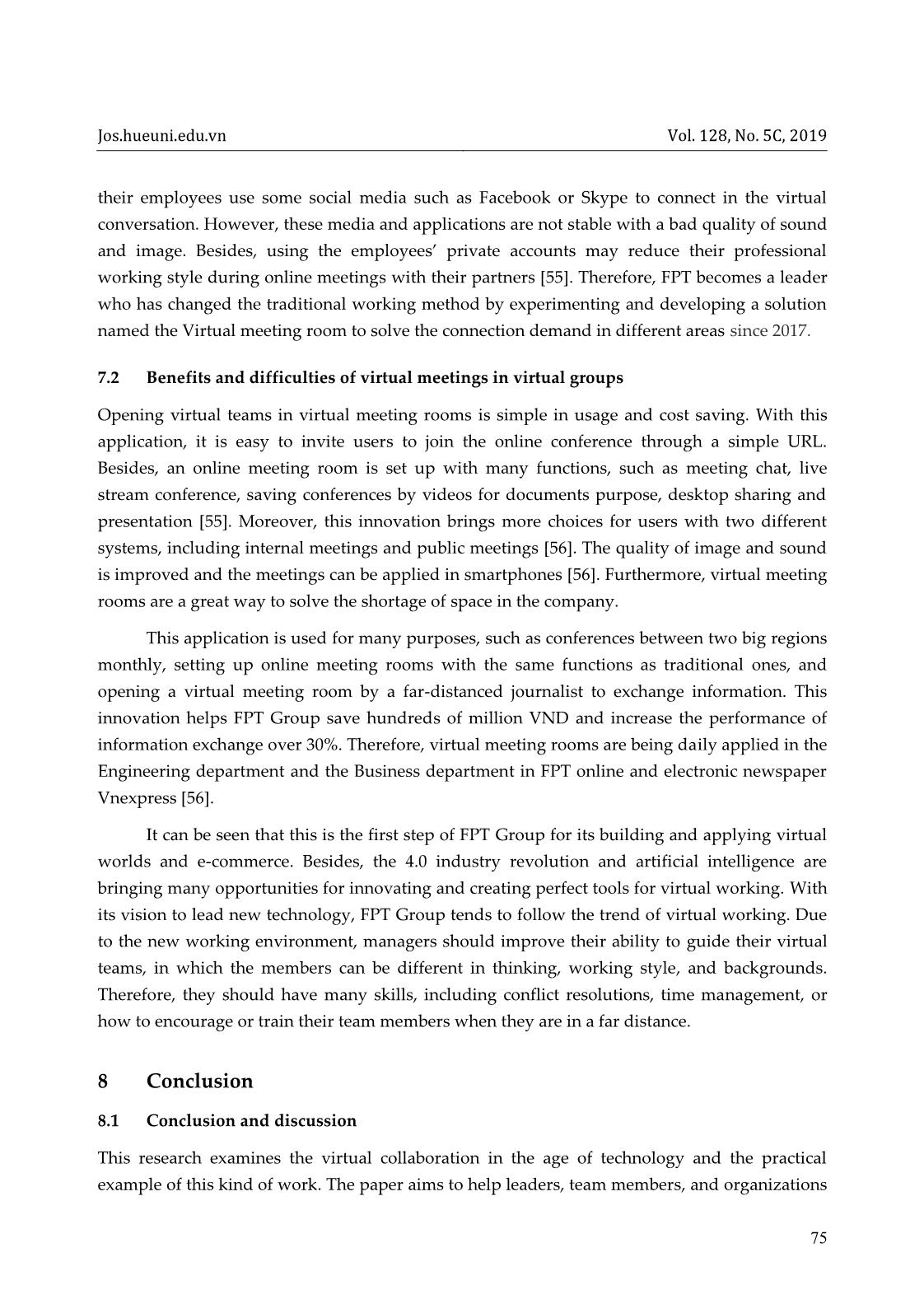
Trang 9
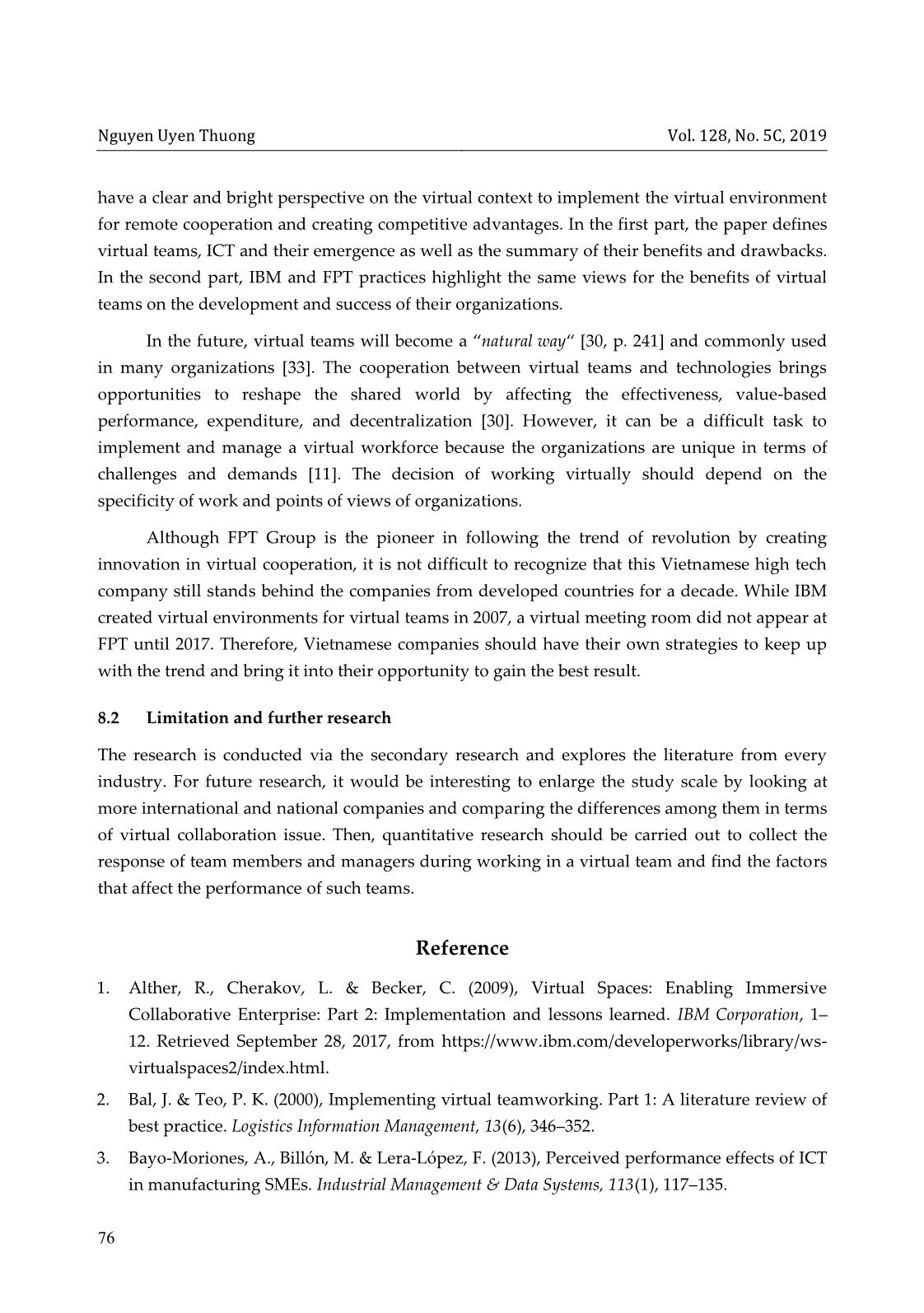
Trang 10
Tải về để xem bản đầy đủ
Tóm tắt nội dung tài liệu: Virtual teams in the digital age
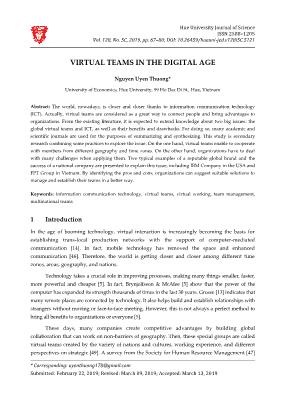
t stable with a bad quality of sound and image. Besides, using the employees’ private accounts may reduce their professional working style during online meetings with their partners [55]. Therefore, FPT becomes a leader who has changed the traditional working method by experimenting and developing a solution named the Virtual meeting room to solve the connection demand in different areas since 2017. 7.2 Benefits and difficulties of virtual meetings in virtual groups Opening virtual teams in virtual meeting rooms is simple in usage and cost saving. With this application, it is easy to invite users to join the online conference through a simple URL. Besides, an online meeting room is set up with many functions, such as meeting chat, live stream conference, saving conferences by videos for documents purpose, desktop sharing and presentation [55]. Moreover, this innovation brings more choices for users with two different systems, including internal meetings and public meetings [56]. The quality of image and sound is improved and the meetings can be applied in smartphones [56]. Furthermore, virtual meeting rooms are a great way to solve the shortage of space in the company. This application is used for many purposes, such as conferences between two big regions monthly, setting up online meeting rooms with the same functions as traditional ones, and opening a virtual meeting room by a far-distanced journalist to exchange information. This innovation helps FPT Group save hundreds of million VND and increase the performance of information exchange over 30%. Therefore, virtual meeting rooms are being daily applied in the Engineering department and the Business department in FPT online and electronic newspaper Vnexpress [56]. It can be seen that this is the first step of FPT Group for its building and applying virtual worlds and e-commerce. Besides, the 4.0 industry revolution and artificial intelligence are bringing many opportunities for innovating and creating perfect tools for virtual working. With its vision to lead new technology, FPT Group tends to follow the trend of virtual working. Due to the new working environment, managers should improve their ability to guide their virtual teams, in which the members can be different in thinking, working style, and backgrounds. Therefore, they should have many skills, including conflict resolutions, time management, or how to encourage or train their team members when they are in a far distance. 8 Conclusion 8.1 Conclusion and discussion This research examines the virtual collaboration in the age of technology and the practical example of this kind of work. The paper aims to help leaders, team members, and organizations Nguyen Uyen Thuong Vol. 128, No. 5C, 2019 76 have a clear and bright perspective on the virtual context to implement the virtual environment for remote cooperation and creating competitive advantages. In the first part, the paper defines virtual teams, ICT and their emergence as well as the summary of their benefits and drawbacks. In the second part, IBM and FPT practices highlight the same views for the benefits of virtual teams on the development and success of their organizations. In the future, virtual teams will become a “natural way“ [30, p. 241] and commonly used in many organizations [33]. The cooperation between virtual teams and technologies brings opportunities to reshape the shared world by affecting the effectiveness, value-based performance, expenditure, and decentralization [30]. However, it can be a difficult task to implement and manage a virtual workforce because the organizations are unique in terms of challenges and demands [11]. The decision of working virtually should depend on the specificity of work and points of views of organizations. Although FPT Group is the pioneer in following the trend of revolution by creating innovation in virtual cooperation, it is not difficult to recognize that this Vietnamese high tech company still stands behind the companies from developed countries for a decade. While IBM created virtual environments for virtual teams in 2007, a virtual meeting room did not appear at FPT until 2017. Therefore, Vietnamese companies should have their own strategies to keep up with the trend and bring it into their opportunity to gain the best result. 8.2 Limitation and further research The research is conducted via the secondary research and explores the literature from every industry. For future research, it would be interesting to enlarge the study scale by looking at more international and national companies and comparing the differences among them in terms of virtual collaboration issue. Then, quantitative research should be carried out to collect the response of team members and managers during working in a virtual team and find the factors that affect the performance of such teams. Reference 1. Alther, R., Cherakov, L. & Becker, C. (2009), Virtual Spaces: Enabling Immersive Collaborative Enterprise: Part 2: Implementation and lessons learned. IBM Corporation, 1– 12. Retrieved September 28, 2017, from https://www.ibm.com/developerworks/library/ws- virtualspaces2/index.html. 2. Bal, J. & Teo, P. K. (2000), Implementing virtual teamworking. Part 1: A literature review of best practice. Logistics Information Management, 13(6), 346–352. 3. Bayo-Moriones, A., Billón, M. & Lera-López, F. (2013), Perceived performance effects of ICT in manufacturing SMEs. Industrial Management & Data Systems, 113(1), 117–135. Jos.hueuni.edu.vn Vol. 128, No. 5C, 2019 77 4. Bergiel, J. B., Bergiel, E. B. & Balsmeier, P. W. (2008), Nature of virtual teams: a summary of their advantages and disadvantages. Management Research News, 31(2), 99–110. 5. Brynjolfsson, E. & McAfee, A. (2011), Race Against The Machine: How the Digital Revolution is Accelerating Innovation, Driving Productivity, and Irreversibly Transforming Employment and the Economy: Lexington, Massachusetts: Digital Frontier Press. 6. Cascio, W. F. (2000), Managing a virtual workplace. Academy of Management Executive, 14(3), 81–90. 7. Cherbakov, L., Brunner, R., Smart, R. & Lu, C. (2009), Virtual Spaces: Enabling Immersive Collaborative Enterprise, Part 1: Introduction on the opportunities and technologies. IBM Corporation, 1–16. Retrieved September 28, 2017, from https://www.ibm.com/developerworks/library/ws-virtualspaces/index.html. 8. Crouch, S. & Housden, M. (2003), Marketing research for managers (3rd ed.). Amsterdam, London: Butterworth-Heinemann. 9. Davis, G. B. (2002), Anytime/Anyplace Computing and the Future of Knowledge Work. Communications of the ACM, 45(12), 67–73. 10. Fisher, A. (2009), How to build a (strong) virtual team. Fortune Magazine. Retrieved October 01, 2017, from .htm. 11. Garff, M. (2011), Implementing a Virtual Workforce. T+D, 65(11), 18. 12. Glass, G. V. (1976), Primary, Secondary, and Meta-Analysis of Research. Educational Researcher, 5(10), 3–8. 13. Grosse, C. U. (2002), Managing Communication within Virtual Intercultural Teams. Business Communication Quarterly, 65(4), 22–38. 14. Harald, B. & Philip, T. (2011), Local, global and virtual buzz: The importance of face-to-face contact in economic interaction and possibilities to go beyond. Geoforum, 42(5), 520–529. 15. Hegar, K. W. & Hodgetts, R. M. (2012), Modern human relations at work (11th ed.). Australia, Mason OH: South-Western Cengage Learning. 16. Henry, J. E. & Hartzler, M. (1998), Tools for virtual teams: A team fitness companion / Jane E. Henry, Meg Hartzler. Milwaukee, Wis: ASQ Quality Press. 17. Hill, E. J., Ferris, M. & Märtinson, V. (2003), Does it matter where you work?: A comparison of how three work venues (traditional office, virtual office, and home office) influence aspects of work and personal/family life. Journal of Vocational Behavior, 63(2), 220–241. 18. Hinds, P. J. & Bailey, D. E. (2000), Virtual teams: Anticipating the impact of virtuality on team process and performance. Academy of Management Proceedings & Membership Directory, C1-C6. Nguyen Uyen Thuong Vol. 128, No. 5C, 2019 78 19. IBM (2003), Virtual teaming: You don’t know me, but Executive technology report, IBM Corporation, 1–12. Retrieved 5. October 2017, from 07.ibm.com/services/pdf/etr_virtualteam.pdf. 20. IBM (2008), Workforce Diversity. IBM Corporation, Australia. Retrieved December 07, 2017, from https://www.shrm.org/ResourcesAndTools/hr-topics/global- hr/Documents/GL_9833_diversity_nocov.08.pdf. 21. IBM (2015), Diversity & Inclusion: Diversity of People. Diversity of thought. A smarter way to innovate every day. IBM Corporation, the United States of America. Retrieved December 07, 2017, from 03.ibm.com/employment/us/diverse/downloads/ibm_diversity_brochure.pdf. 22. IBM (2016), IBM Annual Report. International Business Machines Corporation, United States of America, 1–159. Retrieved September 29, 2017, from https://www.ibm.com/annualreport/. 23. Isidore, C. (2017, May 19), IBM tells employees working at home to get back to the office. Retrieved October 02, 2017, from at-home/index.html. 24. Jelavic, M. & Salter, D. (2017), Managing Transnational Virtual Teams: Cultural and Technological Considerations. Canadian Manager, 42(1), 12–15. 25. Johnson, C. (2002), Managing Virtual Teams. HR Magazine, 47(6), 68. 26. Kanawattanachai, P. & Yoo, Y. (2002), Dynamic nature of trust in virtual teams. The Journal of Strategic Information Systems, 11(3-4), 187–213. 27. Kleis, L., Chwelos, P., Ramirez, R. V. & Cockburn, I. (2012), Information Technology and Intangible Output: The Impact of IT Investment on Innovation Productivity. Information Systems Research, 23(1), 42–59. 28. Kraut, R. & Burke, M. (2015), Internet Use and Psychological Well-Being: Effects of Activity and Audience. Communications of the ACM, 58(12), 94–100. 29. Laitinen, K. & Valo, M. (2018), Meanings of communication technology in virtual team meetings: Framing technology-related interaction. International Journal of Human-Computer Studies, 111, 12–22. 30. Lipnack, J. & Stamps, J. (1997), Virtual teams: Reaching across space, time, and organizations with technology / Jessica Lipnack & Jeffrey Stamps. New York, Chichester: Wiley. 31. Lipnack, J. & Stamps, J. (2000), Virtual Teams: People Working Across Boundaries with Technology (2., Auflage). New York, NY: John Wiley & Sons. 32. Madadipouya, K. (2015), A Review On The Strategic Use Of IT Applications In Achieving And Sustaining Competitive Advantage. International Journal of Managing Public Sector Information and Communication Technologies, 6. Jos.hueuni.edu.vn Vol. 128, No. 5C, 2019 79 33. Marlow, S. L., Lacerenza, C. N. & Salas, E. (2017), Communication in virtual teams: A conceptual framework and research agenda. Human Resource Management Review, 27(4), 575–589. 34. McDonough, E. (2001), An investigation of the use of global, virtual, and collocated new product development teams. Journal of Product Innovation Management, 18(2), 110–120. 35. National Study of Employers (2012), Society for Human Resource Management, 1–51. 36. National Study of Employers (2016), Society for Human Resource Management, 1–75. 37. OECD (2009), The Guide to Measure the Information Society, 1–220. Retrieved September 26, 2009, from 38. OECD (2017), OECD Employment Outlook 2017: OECD Publishing. 39. Olaisen, J. & Revang, O. (2017), Working smarter and greener: Collaborative knowledge sharing in virtual global project teams. International Journal of Information Management, 37(1), 1441–1448. 40. Pan, S. & Jordan-Marsh, M. (2010), Internet use intention and adoption among Chinese older adults: From the expanded technology acceptance model perspective. Computers in Human Behavior, 26(5), 1111–1119. 41. Parsons, G. L. (1984), Information technology: a new competitive weapon. McKinsey Quarterly. (2), 45–60. 42. Prikladnicki, R., Perin, M. & Marczak, S. (2016), Virtual Team Configurations that Promote Better Product Quality. Piscataway, NJ: IEEE. 43. Rice, D. J., Davidson, B. D., Dannenhoffer, J. F. & Gay, G. K. (2007), Improving the Effectiveness of Virtual Teams by Adapting Team Processes. Computer Supported Cooperative Work (CSCW), 16(6), 567–594. 44. RW3 CultureWizard (2016), Trends in Global Virtual Teams: Virtual Teams Survey Report. RW3CultureWizard. Retrieved December 10, 2017. 45. Sarah, K. (2017, March 21), IBM, remote-work pioneer, is calling thousands of employees back to the office. Retrieved September 30, 2017, from https://qz.com/924167/ibm-remote- work-pioneer-is-calling-thousands-of-employees-back-to-the-office/. 46. Smith, P. & Tom, C. (2014), Impact of Emerging Digital Technologies on Leadership in Global Business: IGI Global. 47. Society for Human Resource Management (2012, July 13), SHRM: Virtual Teams Utilized by Nearly Half of Organizations Surveyed. Society for Human Resource Management. Retrieved October 2017, from https://www.shrm.org/about-shrm/press-room/press- releases/pages/virtualteamspoll.aspx. Nguyen Uyen Thuong Vol. 128, No. 5C, 2019 80 48. Tieman, R. (2012, March 15), From teamwork to collaboration. Financial Times, from https://www.ft.com/content/9048279e-4778-11e1-b646-00144feabdc0?mhq5j=e5. 49. Tsedal, N. (2015), Global team that work. Harvard Business Review, 76–81. 50. Weller, C. (2017, May 18), IBM was a pioneer in the work-from-home revolution — now it's cracking down. Retrieved October 05, 2017, from slashes-work-from-home-policy-2017-5. 51. White, M. C. (2017, May 23), IBM Tells Its Remote Employees to Get Back to the Office. Retrieved October 02, 2017, from https://www.nbcnews.com/business/business-news/ibm- tells-its-remote-employees-get-back-office-n763441. 52. Woodford, C. (2006), Digital technology. Science in focus. London: Evans. 53. Ministry of Industry and Trade of the Socialist Republic of Vietnam (11/4/2017), Dien dan cach mang cong nghiep lan thu 4, from %C4%91an-cach-mang-cong-nghiep-lan-thu-4-109680-22.html,11/04/2017 54. FPT Telecom, from https://fpt.vn/en/about-fpt-telecom/fpt-corporation.html 55. Chungta, the internal news page of FPT Group (31/05/2018), 5 ideas continues to the last round of Ikhien number 3, from khao-ikhien-so-3-65407.html (in Vietnamese) 56. Chungta, the internal news page of FPT Group (07/06/1018), FPT online saves hundred millions VND by the virtual meeting room, from online-tiet-kiem-hang-tram-trieu-dong-nho-phong-hop-ao-65519.html (in Vietnamese) 57. The University of Edinburgh (04/07/2017), How to evaluate website content, from https://www.ed.ac.uk/information-services/library-museum-gallery/finding- resources/library-databases/databases-overview/evaluating-websites.
File đính kèm:
 virtual_teams_in_the_digital_age.pdf
virtual_teams_in_the_digital_age.pdf

